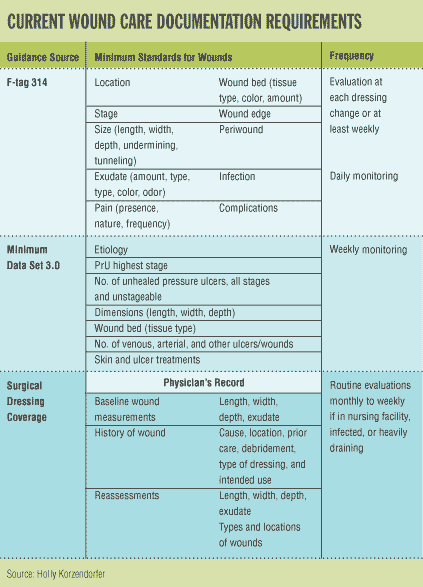
Wounds and pressure ulcers afflicting long term care residents incite visceral reactions in lay persons due to the fragile population served and the misconception that poor care is always the causative factor. In addition, such misconceptions have been known to lead to criminal charges, malpractice suits, and federal regulations to protect this vulnerable population.
As a result, there are significant regulatory guidelines for caregivers, surveyors, and suppliers as to minimal documentation requirements for all wound types. The most basic premise behind these guidelines is to document what is seen, clearly enough for another caregiver to understand the wound presentation and treatment interventions, and for a supplier to provide—and be reimbursed for—the appropriate materials needed for treatment interventions.
Documentation is also critical in the unfortunate cases where a lawyer is needed to defend charges. In such cases, trouble could arise when the minimum documentation standards are not met or when contradictory information is present in the medical record.
F-tags, MDS 3.0 Provide Guidance
Those working in long term care are familiar with the angst prior to the survey process and the fear of being cited for insufficient care via an F-tag. The tags most commonly associated with wounds and pressure ulcers are F309 and F314. The “State Operations Manual Guidance to Surveyors for Long-Term Care Facilities” clearly states the requirements for minimal wound documentation standards and pressure ulcer risk assessment.
F-tag 314 says that with each dressing change, or at least weekly, an evaluation of the pressure ulcer should be documented, including the following criteria at a minimum: location; stage; size (length, width, depth, undermining, or tunneling); exudate (amount, type, color, odor); the presence, nature of, and frequency of pain; the tissue types and color, and amounts present in the wound bed; wound edges; and the presence of infection or possible complications.
Photographs may be used if the facility has a protocol consistent with accepted standards. F-tag 314 also requires daily monitoring and documentation of the ulcer if a dressing is not present, the status of the dressing and the area surrounding the ulcer, and possible complications and pain.
The minimum data set 3.0 “Resident Assessment Instrument Manual” collects the following data points in Skin Conditions—Section M: pressure ulcer risk; etiology; highest-stage pressure ulcer; number of unhealed pressure ulcers of all stages, including non-stageable ones; pressure ulcer assessments, including dimensions in length, width, and depth; tissue type, including most severe; the number of worsening and healed pressure ulcers; the number of venous, arterial, and other ulcers or wounds, such as diabetic foot, surgical sites, burns, and skin tears; and skin and ulcer treatments.
These data are derived from the medical record, skin care flow sheets, tracking forms, and information gathered upon admission or within the seven-day look-back period. Thus, weekly assessments capturing at the data points are pivotal.
Checklists, Forms Make It Easier
The Surgical Dressings Coverage and Documentation Checklist, available via National Government Services, a Centers for Medicare & Medicaid Services (CMS) contractor (www.ngsmedicare.com), also clarifies that the following criteria for documentation are expected in the physician’s record: baseline wound measurements, such as length, width, depth, and exudate; routine wound evaluations at least monthly, and more frequently for patients in nursing facilities or with heavily draining or infected wounds; and patient history relevant to the wound, including cause, location, prior care, debridement, type of surgical dressing, and its intended use, such as for primary or secondary.
Continued coverage requires monthly assessments, including length, width, depth, and exudate, in addition to types and locations of the wounds, again more frequently if in a nursing facility or if infected or heavily draining.
Furthermore, the Agency for Healthcare Research and Quality funds the On-Time Quality Improvement for Long-Term Care Program, which provides background, materials, and tools for the Pressure Ulcer Healing Project, including detailed Wound Assessment Forms, which can be found at:
www.ahrq.gov/researc/pressureulcerhealing.
It is important to note that Medicare requires that wound evaluations be performed by a nurse, physician, or other health care professional, as the forms available for this project lack signature lines for identifying the assessing health care professional—a significant deficiency for meeting a key Medicare requirement that may be overlooked by someone using the forms.
Documentation Continuity, Consistency Vital
Given the dearth of wound documentation required by CMS (see table, below) and the state of medical records in nursing homes where that information may be found in the physician’s notes, nurse’s notes, or various flow sheets such as Treatment Administration Records, one may have to search to gather all the critical documentation elements. And that search may lead to conflicting or contradictory information.

For example, in one instance a nursing home resident received a feeding tube placement in November 2011 with the physician’s note briefly confirming the presence of such a tube, and the nurses’ notes mentioned flushing of the feeding tube, yet the MDS 3.0 record lacked the information in the appropriate section (K).
This resident also had suffered complications related to the feeding tube that led to significant peritubular skin damage that was not recognized in the chart. This scenario does not allow for adequate care planning or for quality of care as the documentation did not clearly represent the resident’s state of health or needs. It also prevented the implementation/provision of necessary services to allow the resident to heal and achieve or maintain the highest quality of life possible.
Measurements Must Match
Another common occurrence is that of conflicting wound measurements and exudate levels across the sections of the medical record and interdisciplinary team notes.
One note may have disclosed all necessary measurements, such as length, width, and depth, while another has only the length and depth, and the numbers in the notes may be transposed or not matching at all. Another scenario may have the wound site labeled differently in the various sections. Additionally, incomplete physician notes or orders stating to cover the wound with a protective dressing or a clean dry dressing are not sufficient enough to relay the care being provided to another health care provider, a surveyor, or a judge.
This inconsistent and fragmented method of documentation has the potential to undermine continuity of care, particularly for the medically complex resident with wounds, who is most at risk. These medical complexities require an even more robust understanding of wound management.
Consider A Holistic View
Treatment decisions, evaluations on wound status, and dressing efficacy are made weekly, if not at each dressing change. But current documentation standards provide little framework to prompt the health care practitioner to identify, and thus incorporate, “other relevant criteria” into wound assessment and care planning approaches when working with a more medically diverse population.
More often than not, the available assessments and supplemental documentation lack sufficient clinical context to offer patients a more holistic solution to elderly wound care patients.
Integration of a clinically complicating data set into wound assessments for residents already identified as at-risk enables caregivers to have relevant information for developing treatment protocols tailored to the unique needs of each resident.
Given the varying skill level of facility wound care practitioners, efforts to create more user friendly “prompts” could result in resident-centered treatment decisions that reflect the complexity of a resident’s condition(s), a better undertanding of the consequential impact on wound healing, and the therapeutic intent of interventions.
Widespread incorporation and utilization of such documentation, supplemented with photo documentation according to accepted standards, will go a long way to impact and improve wound healing outcomes within this vulnerable population. Go to www.providermagazine.com for a sample evaluation form that incorporates such prompts.
Holly Korzendorfer, PT, PhD, CWS, FACCWS, is vice president of clinical development at DermaRite, Paterson, N.J. Adrianna Cantu, PT, CWS, FACCWS, is vice president of clinical operations for American Medical Technologies, western division. Cantu provides strategic leadership and direction to the company’s clinicians.